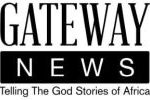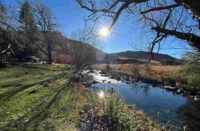
The first article in a series on the Welsh Revival by Gateway News UK correspondent Charles Gardner who recently visited Wales with his wife, Linda
Amid great expectancy of a renewed outpouring of the Spirit in the land of revivals, my wife and I were profoundly blessed and stirred by a recent visit to Wales.
We sat in the Moriah Chapel at Loughor, near Swansea, where the famous Welsh Revival broke out on October 31 1904, and had a real taste of those momentous times as we were guided around the premises by a man whose uncle was a close friend of Evan Roberts, the human instrument used by God as the spark of that great movement affecting much of the world, including Africa.
I also noted the significance of the chapel’s name as it was Mt Moriah where Abraham was prepared to offer up his son Isaac as a sacrifice and where, close by, Jesus died for the sins of the world at Calvary.

And this was not the only connection with Israel – more of which later.

We are hiring
Apply via links
Finance Administrator
https://ips.bamboohr.com/careers/36
Executive Assistant
https://ips.bamboohr.com/careers/29
- Advertisement -
In recalling the total surrender of those young men (the initial outpouring effectively started with a youth meeting), one of our group prayed “Bend us, Lord!” as she echoed the heartfelt cry of the revival’s 25-year-old leader for God to break their resistance to the Holy Spirit’s power.
It was an awesome moment as we became aware of the great need of our nation (in the UK as a whole) for restoration and reformation. Then we sang Here is love, vast as the ocean, one of the revival’s key hymns – first in Welsh, then in English.
Our visit there was part of a weekend conference of the UK Fellowship of Full Gospel Churches, an international network of ministers dedicated to proclaiming Christ in all His fullness.
The event was hosted at the Bible College of Wales, which has itself been mightily used in world mission and was a product of the 1904/5 revival. We enjoyed glorious worship in the same room where legendary intercessor Rees Howells and his students prayed through to victory for Britain and the allies during World War II and later for Israel’s recognition at the United Nations.
Participants had flown in from throughout the United States as well as from Holland, while others came from across the south of England and Wales. We were the lone visitors from the north.
Although a relatively small gathering with no more than 50 taking part, most of them were men and women of great spiritual stature and faith – at least one had met with US presidents, while others had walked with the likes of Billy Graham and had witnessed God’s miraculous guidance over many years.
Dick Funnell, from New Orleans, shared his extraordinary journey of how God had led him to come and live on the west coast of Wales where he and his Guatemalan wife Gladys now have keys to a small chapel where they have been praying daily for the past 13 years, convinced that revival is on its way.
Prayer for Britain, Israel
As we prayed and lifted our hands in worship, we were aware of the crucial part played by Howells and his students who interceded day and night for a nation facing disaster at the time of Dunkirk. Their God-ordained prayers brought us back from the brink of destruction. They also prayed through to victory at the UN for Israel’s recognition in November 1947, having also made provision for Jewish children escaping the Nazi net.
A love for Israel was due not only to a proper understanding of the Bible, but also to the part they had played in the founder’s conversion. Howells actually committed his life to Christ in America, where he had gone to seek his fortune, and it had come about through a Jewish evangelist, Maurice Reuben, who had paid a huge price for following Jesus, being disowned by his wealthy family and denied his part-ownership of a Pittsburgh store.
Maurice himself had found the Lord through the witness of a man he had asked – because he always seemed cheerful – if he had been “born happy”, to which the man had replied that his happiness only dated from his “second birth”.
Rees, who was the same age as Evan Roberts, returned to Wales to help with the revival. Following a powerful encounter with the Holy Spirit, he lived a radical life of faith as he reached out to drunkards and tramps – cutting down his meals in order to identify with them. And he took on formidable challenges such as praying for – and witnessing to – a village untouched by the revival, and for the healing for sick people doctors had written off.
Evan, meanwhile, was unschooled as, when his father was injured down the mine, he took his place, aged 11, in order to provide an income for his family.
Later, feeling called to pastoral ministry, he left home to acquire the necessary academic qualifications but before long had a deep experience of the Holy Spirit after hearing a speaker from the Welsh equivalent of the Keswick Convention.
He returned to his home village and asked if he could hold a youth meeting to which 16 youngsters turned up. Revival broke out, and services lasted virtually through the night. Miners coming off their shift would join the queues for the chapels; as soon as one was filled they’d tramp off to find the next. Lights would be burning through the night as tens of thousands throughout the principality were convicted of sin by the presence of God and the preaching of the gospel. It is estimated that as many as 100 000 were swept into the kingdom over a four-month period as people couldn’t get enough of being in God’s presence.
It wasn’t the first time Wales had seen revival – Howell Harris and others had led a similar movement in the late 18th century, and even John Wesley had preached at Loughor in those days. Another revival broke out in 1859 – also touching many other parts of the world.
In fact, it was in the midst of the earlier movement that a hugely significant event took place that was to lead to the foundation of the Bible Society through which the Word of God was translated into hundreds of languages and distributed throughout the world.
The event in question was a 26-mile walk over the mountains of North Wales by 15-year-old Mary Jones in order to purchase a copy of the Welsh Bible for which she had saved up for six years. Her extraordinary feat awakened the need for God’s Word to become available to everyone in their mother tongue.
One of the effects of the 1904 awakening of dynamic Christianity was that the police and magistrates had nothing to do except help control the crowds queuing up for the gospel meetings.
Global impact
The revival spread across the globe, even touching Asia, Africa and St Petersburg in Russia, and it inspired others praying for a similar move in their own localities. This was particularly the case in California, where news of what was happening in Wales galvanised the prayers of American saints and led directly to the Azusa Street, Los Angeles, revival of 1906 — the beginnings of the modern-day Pentecostal movement, with a similar outpouring taking place in Sunderland, England, in 1907 led by Church of England vicar Alexander Boddy, who had earlier come to witness the work of Evan Roberts in Wales.

The revival produced outstanding leaders including George and Stephen Jeffries and, of course, Rees Howells who helped spread the blessing to South Africa when he and his wife Elizabeth went out as missionaries under the auspices of the South African General Mission founded by Rev Andrew Murray.
Howells later founded his world-changing Bible College in 1928. One student, a young German called Reinhard Bonnke, graduated in 1960 and subsequently won millions of people to the Lord through his huge missions across Africa and other parts of the world.
A young Billy Graham also visited the Loughor chapel back in 1946 when he is understood to have had a profound experience of the Holy Spirit. Millions the world over benefited from that!
Part 2 next week.
Additional material sourced from Rees Howells, Intercessor by Norman Grubb published by Lutterworth Press






